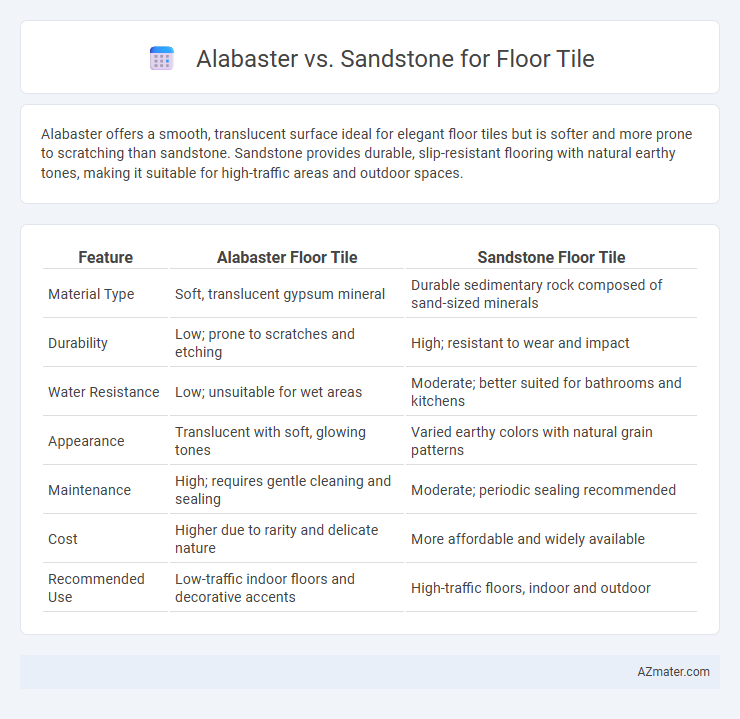Alabaster offers a smooth, translucent surface ideal for elegant floor tiles but is softer and more prone to scratching than sandstone. Sandstone provides durable, slip-resistant flooring with natural earthy tones, making it suitable for high-traffic areas and outdoor spaces.
Table of Comparison
| Feature | Alabaster Floor Tile | Sandstone Floor Tile |
|---|---|---|
| Material Type | Soft, translucent gypsum mineral | Durable sedimentary rock composed of sand-sized minerals |
| Durability | Low; prone to scratches and etching | High; resistant to wear and impact |
| Water Resistance | Low; unsuitable for wet areas | Moderate; better suited for bathrooms and kitchens |
| Appearance | Translucent with soft, glowing tones | Varied earthy colors with natural grain patterns |
| Maintenance | High; requires gentle cleaning and sealing | Moderate; periodic sealing recommended |
| Cost | Higher due to rarity and delicate nature | More affordable and widely available |
| Recommended Use | Low-traffic indoor floors and decorative accents | High-traffic floors, indoor and outdoor |
Introduction to Alabaster and Sandstone Floor Tiles
Alabaster floor tiles offer a smooth, translucent surface characterized by their soft, warm white hues, making them ideal for creating elegant and luminous indoor spaces. Sandstone floor tiles present a natural, textured appearance with earthy tones ranging from beige to reddish-brown, providing durability and a slip-resistant surface suitable for high-traffic areas. Both materials vary in hardness and porosity, influencing maintenance requirements and suitability for different flooring environments.
Composition and Geological Origins
Alabaster is a fine-grained, crystalline form of gypsum composed primarily of calcium sulfate dihydrate, originating from sedimentary deposits in evaporative marine environments. Sandstone consists of compacted sand-sized mineral particles, mainly quartz and feldspar, formed from the lithification of sediment in river, beach, or desert settings. The distinct geological origins and mineral compositions influence their hardness, porosity, and suitability for floor tile applications.
Visual Aesthetics and Color Variations
Alabaster floor tiles exhibit a creamy white to translucent appearance, offering a smooth, elegant finish that enhances light reflection and adds a luxurious, airy atmosphere to interior spaces. Sandstone tiles showcase earthy tones ranging from warm reds and browns to soft yellows and grays, providing a natural, textured look that complements rustic and outdoor designs. The subtle veining in alabaster contrasts with the granular, layered patterns of sandstone, making each material distinct in visual appeal and suitability for different interior styles.
Durability and Hardness Comparison
Alabaster floor tiles exhibit lower durability and hardness compared to sandstone, making them more susceptible to scratches and wear in high-traffic areas. Sandstone ranks higher on the Mohs hardness scale, typically around 6 to 7, providing better resistance to abrasion and impact, which is ideal for flooring. The natural porosity of sandstone also contributes to its toughness, while alabaster's softness requires more maintenance to preserve its appearance over time.
Maintenance and Cleaning Requirements
Alabaster floor tiles require gentle cleaning with mild, pH-neutral cleaners to prevent etching and surface damage, as the stone is soft and porous. Sandstone tiles are relatively easier to maintain, demanding regular sealing to protect against stains and moisture, with routine sweeping and mopping using non-acidic solutions. Both materials benefit from immediate spill cleanup, but alabaster's delicate nature necessitates more cautious upkeep compared to the durable, natural textured surface of sandstone.
Moisture Resistance and Porosity
Alabaster exhibits low porosity, making it highly moisture-resistant and less prone to water absorption compared to sandstone, which is naturally more porous and susceptible to moisture damage. Due to sandstone's higher porosity, it requires sealing and regular maintenance to prevent staining and erosion in flooring applications. Moisture resistance in alabaster results in enhanced durability and longevity for floor tile installations in damp or humid environments.
Installation Process and Techniques
Alabaster floor tiles require delicate handling during installation due to their softness and susceptibility to scratching, often necessitating a specialized adhesive and a gentle trowel technique. Sandstone tiles, being more durable and porous, demand proper sealing before installation to prevent staining and typically use a standard thin-set mortar for secure adhesion. Both materials benefit from precise leveling and spacing tools to ensure a uniform, professional finish, but sandstone's robustness allows for faster, less cautious installation compared to alabaster.
Cost Analysis and Long-Term Value
Alabaster floor tiles typically cost more than sandstone due to their rarity and delicate nature, influencing initial investment decisions. Sandstone offers a more budget-friendly option with moderate durability, making it suitable for high-traffic areas while maintaining aesthetic appeal. Over time, alabaster's susceptibility to scratching and staining may increase maintenance expenses, whereas sandstone's resilience provides better long-term value and reduced upkeep costs.
Environmental Impact and Sustainability
Alabaster flooring tiles, derived primarily from gypsum, exhibit lower environmental impact due to their abundant natural availability and minimal processing emissions compared to sandstone, which requires extensive quarrying often leading to significant habitat disruption and higher carbon footprints. Sandstone's durability and natural weather resistance make it a longer-lasting option, potentially reducing the need for frequent replacements and resource consumption over time. However, alabaster's biodegradability and lower extraction impact position it as a more sustainable choice in eco-conscious construction and design projects.
Best Applications: Where to Use Each Stone
Alabaster floor tiles are ideal for low-traffic areas such as bathrooms, powder rooms, or decorative wall accents due to their softness and susceptibility to scratching. Sandstone offers excellent durability and slip resistance, making it suitable for high-traffic spaces like entryways, patios, and kitchens. Selecting between alabaster and sandstone depends on the balance between aesthetic delicacy and functional toughness required for the specific flooring application.

Infographic: Alabaster vs Sandstone for Floor Tile
 azmater.com
azmater.com